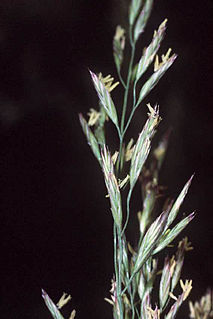
Festuca (fescue) is a genus of flowering plants belonging to the grass family Poaceae. They are evergreen or herbaceous perennial tufted grasses with a height range of 10–200 cm (4–79 in) and a cosmopolitan distribution, occurring on every continent except Antarctica. The genus is closely related to ryegrass (Lolium), and recent evidence from phylogenetic studies using DNA sequencing of plant mitochondrial DNA shows that the genus lacks monophyly. As a result, plant taxonomists have moved several species, including the forage grasses tall fescue and meadow fescue, from the genus Festuca into the genus Lolium, or alternatively into the segregate genus Schedonorus.

Bromus madritensis is a species of brome grass known by the common name compact brome. The specific epithet madritensis refers to Madrid, Spain. It has a diploid number of 28.
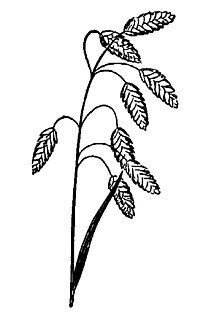
Bromus briziformis is a species of brome grass known by the common name rattlesnake brome. The specific epithet briziformis comes from the resemblance of the grass to grasses of the genus Briza, particularly Briza maxima. The common name is derived from the resemblance of the spikelets to the rattles of rattlesnakes. The grass has a diploid number of 14.

Bromus catharticus is a species of brome grass known by the common names rescuegrass, grazing brome, prairie grass, and Schrader's bromegrass. The specific epithet catharticus is Latin, meaning cathartic. The common name rescuegrass refers to the ability of the grass to provide forage after harsh droughts or severe winters. The grass has a diploid number of 42.

Bromus kalmii, the Arctic brome or prairie brome, is a species of brome grass. It is a native bunchgrass in the North-central and Northeastern United States, the Great Lakes region, and eastern Canada. The specific epithet kalmii refers to its discoverer Pehr Kalm.

Festuca vivipara, the viviparous sheep's-fescue, is a species of grass native to northern Europe, northern Asia, and subarctic North America. The specific epithet vivipara is Latin, referring to the florets' alteration to leafy tufts. The plant can have a diploid number of 28, 49, 56, or 63, though numbers of 21, 35, and 42 have also been reported.
Melica tibetica, is a grass species in the family Poaceae that is endemic to China and can be found in such provinces as Inner Mongolia, Qinghai, Sichuan, and Tibetan Autonomous Region.
Melica radula is a species of grass endemic to China. It grows on grassy mountain slopes and larch forests at 300–1,200 metres (980–3,940 ft) above sea level.
Festuca actae is a species of grass which can be found in New Zealand.
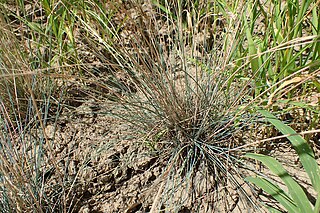
Festuca psammophila is a species of grass which is endemic to Central Europe.

Bromus nottowayanus, the Nottoway Valley brome or satin brome, is a brome grass native to North America. The specific epithet nottowayanus refers to the Nottoway Valley. The grass has a diploid number of 14.

Bromus japonicus, the Japanese brome, is an annual brome grass native to Eurasia. The grass has a diploid number of 14.
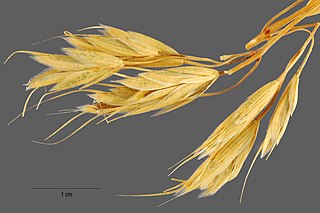
Bromus squarrosus, the rough brome, is a brome grass native to Russia and Europe. The specific epithet squarrosus is Latin, meaning "with spreading tips". The grass has a diploid number of 14.

Festuca brachyphylla, commonly known as alpine fescue or short-leaved fescue, is a grass native to Eurasia, North America, and the Arctic. The grass is used for erosion control and revegetation. The specific epithet brachyphylla means "short-leaved". The grass has a diploid number of 28, 42, or 44.
Festuca saximontana, the rocky mountain fescue or the mountain fescue, is a perennial grass native to North America. The specific epithet saximontana is Latin and means "of the Rocky Mountains". The grass has a diploid number of 42.

Aristida contorta, commonly known as bunched kerosene grass, kerosene grass, bunched windgrass, silvergrass, mulga grass,sand speargrass, and medicine grass, is a species of grass in the family Poaceae that is native in Australia. The Walmajarri name for this species is Ngirrirli.
Bromus pacificus, the Pacific brome, is a perennial grass native to the Pacific coast of North America. Bromus pacificus has a diploid number of 28.
Vulpia elliotea, known by the common name sand fescue or squirreltail fescue, is an annual grass native to the southeastern United States. Its specific epithet elliotea is named for its discoverer, Stephen Elliott.

Glyceria melicaria, the melic mannagrass or northeastern mannagrass, is a perennial grass found in the eastern United States. Its specific epithet melicaria means "similar to Melica". Its diploid number is 40.
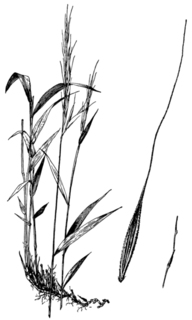
Brachyelytrum erectum, known as the southern shorthusk or the southern long-awned woodgrass, is a perennial grass native to North America. Its specific epithet "erectum" refers to the erect culms of the grass. Its diploid number is 22.














